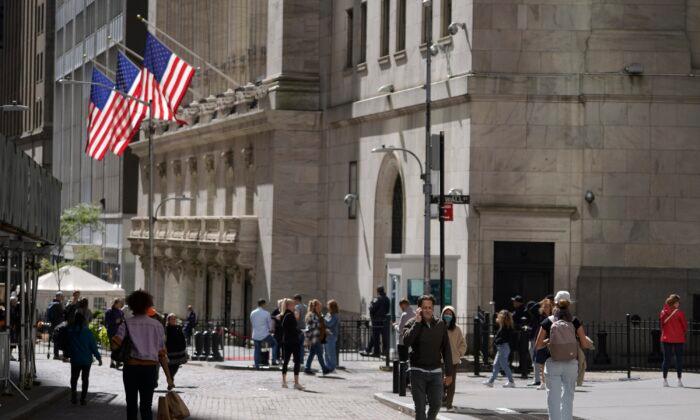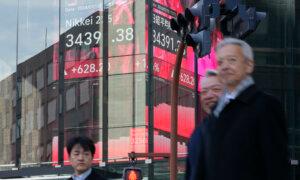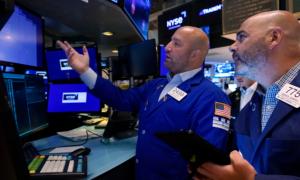NEW YORK—Wall Street rose Wednesday as traders locked in their final moves ahead of a report on inflation, which could show whether all the excitement that’s vaulted stocks toward records is warranted.
The S&P 500 gained 0.6 percent to pull within 0.3 percent of its all-time high set two years ago. The Dow Jones Industrial Average added 0.5 percent, and the Nasdaq composite rose 0.8 percent.
Intuitive Surgical jumped 10.3 percent after the maker of robotic surgery systems said it expects to report stronger revenue for the end of 2023 than analysts expected. Homebuilder Lennar climbed 3.5 percent after it said it would send cash to shareholders by increasing its dividend and authorizing a repurchase of up to $5 billion of its own stock.
But the market’s focus is on Thursday, when the U.S. government will release its latest monthly update on inflation at the consumer level. A cooldown there from its peak in the summer of 2022 has raised hopes that the Federal Reserve may cut interest rates sharply this year. That in turn has sent Treasury yields easing in the bond market and stock prices rallying.
Economists expect Thursday’s report to show prices paid by U.S. consumers were 3.2 percent higher in December than a year earlier, according to FactSet. That would be a slight acceleration from November’s 3.1 percent inflation rate. But after ignoring the effects of food and fuel prices, which can quickly shift from month to month, economists believe underlying inflation trends likely continued to cool.
The Fed has noticed the cooldown in inflation, and it’s hinted at possibly cutting interest rates three times this year. That would be a sharp turnaround after it jacked rates dramatically higher in hopes of slowing the economy and hurting investment prices enough to grind down high inflation.
But many traders are anticipating double that number of rate cuts. Critics say that’s overly optimistic and that the Fed is unlikely to cut so many times unless a recession hits. If Thursday’s inflation data come in warmer than expected, it could upend those hopes and shake the market.
The yield on the 10-year Treasury has already slumped well below its perch above 5 percent in October on strong hopes for rate cuts. It edged a bit higher Wednesday, up to 4.03 percent from 4.02 percent late Tuesday.
On Wall Street, Boeing’s stock stabilized after slumping earlier in the week following the in-flight blowout of one of its planes flying for Alaska Airlines. It rose 0.9 percent.
WD-40 jumped 15.2 percent after reporting stronger profit for the latest quarter than analysts expected.
The big companies in the S&P 500 are set to begin reporting their results for the last three months of 2023 on Friday. Delta Air Lines, JPMorgan Chase, and UnitedHealth Group will be among that day’s headliners.
Analysts are forecasting a half dozen stocks will be responsible for most of the S&P 500’s growth in the last quarter. But trends are improving a bit, according to strategists at Bank of America. They say 66 percent of companies are expected to report growth in profit, up from 64 percent in the third quarter.
“While risks remain, fundamentals are improving and analysts sound more optimistic than they did in” the summer, Ohsung Kwon and Savita Subramanian said in a BofA Global Research report.
Some of Wall Street’s heavier losses Wednesday came from stocks of oil-and-gas companies. Exxon Mobil sank 1 percent, and Devon dropped 1.9 percent.
Crude prices fell after giving up gains from earlier in the day. A barrel of benchmark U.S. oil dropped 87 cents to $71.37 and is down roughly 3 percent for the week. Brent crude, the international standard, sank 79 cents to $76.80 per barrel. The price of natural gas also slumped.
All told, the S&P 500 rose 26.95 points to 4,783.45. The Dow gained 170.57 to 37,695.73, and the Nasdaq climbed 111.94 to 14,969.65.
In stock markets abroad, Tokyo’s Nikkei 225 gained 2 percent to hit its highest level since March 1990 as a weaker yen lifted shares of exporters. Indexes were mostly lower across the rest of Asia and mixed in Europe.
In cryptocurrencies, bitcoin was swinging around $46,000 shortly after the Securities and Exchange Commission said it would allow for the trading of exchange-traded funds that hold actual bitcoins, instead of just futures contracts related to them.
The SEC appeared deeply split over the decision. One commissioner called it an overdue move to give investors the ability to express their thoughts on bitcoin, while another described it as an unsound action that “put us on a wayward path that could further sacrifice investor protection.”
A day earlier, bitcoin swung through a wild ride after the SEC’s account on X, formerly known as Twitter, said that it had approved such ETFs. Soon after, though, the SEC said no approval had been given and that its account had been compromised.
It was the latest eye-twitching shenanigan in a corner of the market that SEC Chair Gary Gensler had called the “Wild West” in 2021 because it didn’t have enough protections for investors at the time.







